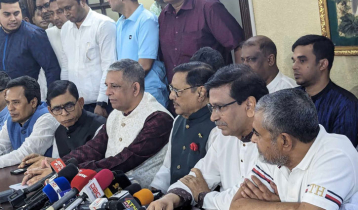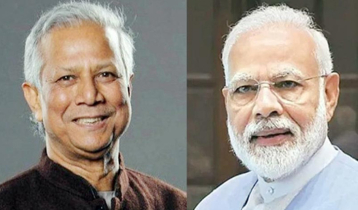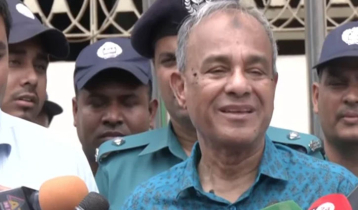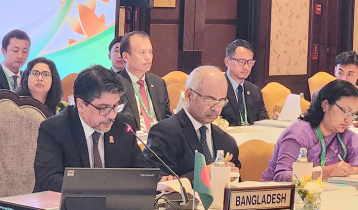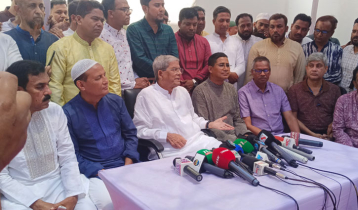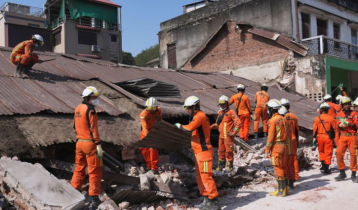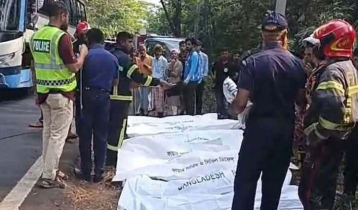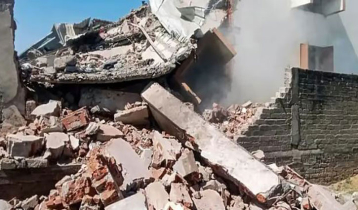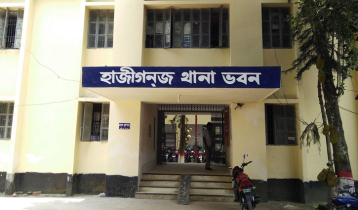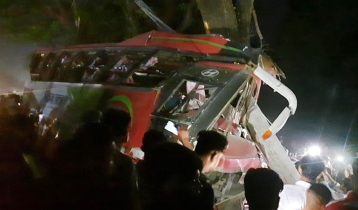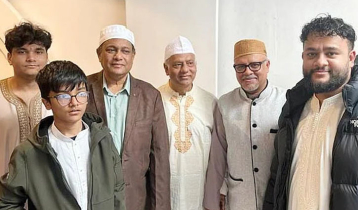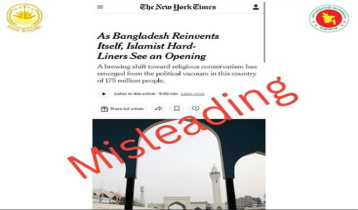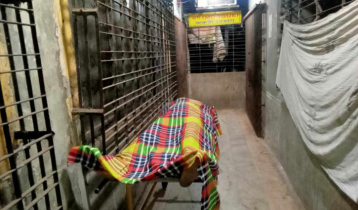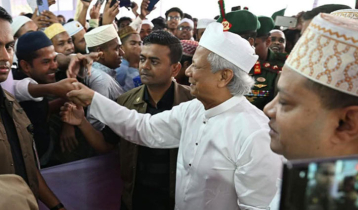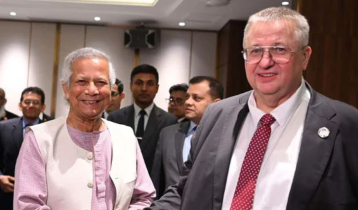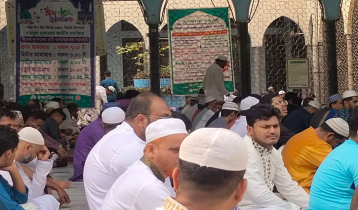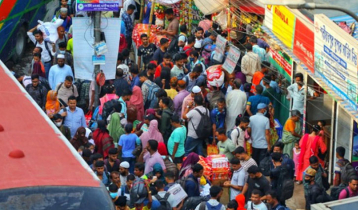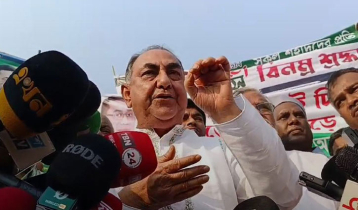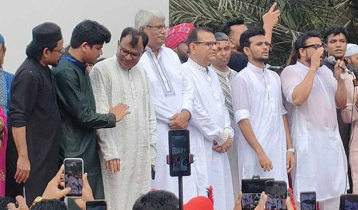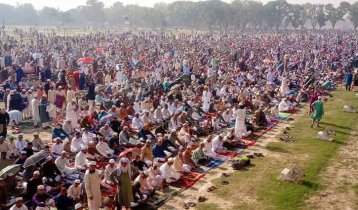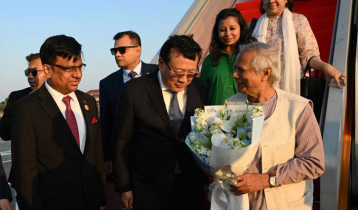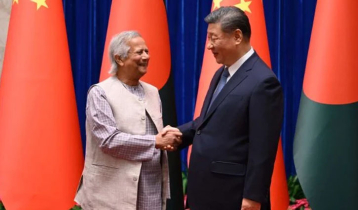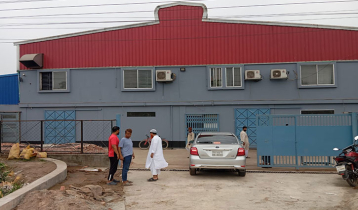Bengali Administrators of Mughal and British India
Monty Siddique || risingbd.com

A view of the Khan Bahadur Salamatullah Mosque – photograph taken in 2012
Our story begins in the village of Tetulia (or Tentulia), which is in the upazila Tala under the district of Satkhira. The village showcases heritage signatures – by way of the Khan Bahadur Salamatullah Mosque and the decaying remnants of Salam Manzil – left behind as legacies of Khan Bahadur Maulvi Qazi Salamatullah.
You could undertake a whirlwind day trip to Tetulia. This would include embarking on a (propeller-driven) flying visit from Dhaka Airport to the airstrip in Jashore, then to Tetulia village by a hired auto vehicle for a few hours’ stay there, back to Jashore by the same and then a return flight back to Dhaka – all in one day. Well, I did it, with a couple of relatives!
Over the last fifteen or so years, sporadic disclosures of snippets of information professing to tell the history behind the Salamatullah Mosque have appeared in the public domain as newspaper articles or through books.
Sadly, many of the claimed “historical” accounts have comprised wrong dates, distorted names, hearsay, unsubstantiated events etc. This is expected; it is perhaps not deliberate, as the sources of information were, evidently, spurious. It is unlikely that the writers had access to copies of the family tree and/or administrative decrees (e.g. Mughal sanads or deeds) to steer them, at least asymptotically, towards the truth.
Against this backdrop, I am writing this article whereby Bangladeshi and foreign tourists alike will be able to digest some of the rich history and heritage of Bangladesh.
Maybe I should enlighten the readers with selected contents of copies of the family tree and sanads I have extracted from a lady (one of several descendants of the Tetulia Qazi Khan family, many of whom are scattered over different Western countries) who resides in Dhaka, and my knowledge (acquired essentially from my dear late father) and research, to render the records straight to the best of my understanding and belief.
Fortunately, the complete family tree (Kursi Nama) is intact and is, interestingly, accompanied by family trees of notable Qazis of Jashore or Jawshore (Satkhira, Khulna and parts of West Bengal came under the umbrella of Jashore at the time). There are such reams of documents that it would take years to translate and interpret them. The documents are old, the ink on many of which has faded; some are damaged; some have repasted cut-outs and others are worm-eaten.
Surprisingly, a partial family tree of our beloved Prophet Muhammad (sallallahu ‘alayhi wa sallam; blessings of Allah and peace be upon him) is also incorporated in the documents.
Interestingly, the family tree begins with the prayer (supplication; du‘aa) from Tirmidhi 3563 (hadith – see the pictorial view hereinunder) about protection against debt.
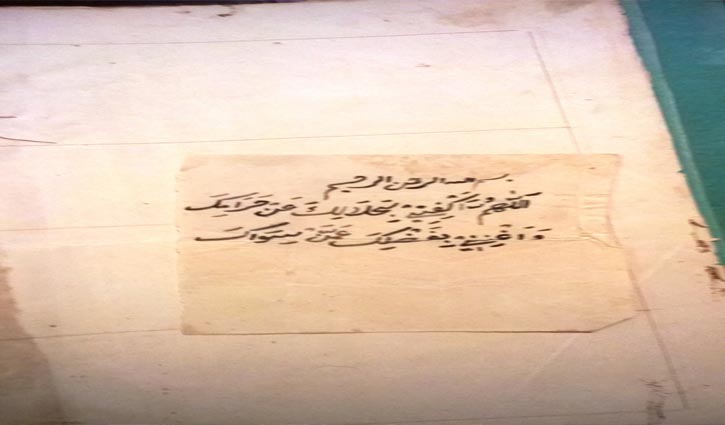
In Arabic it reads: “Bismillahir Rahmanir Raheem. Allahummakfinee bihalaalika ‘an haraamika wa aghninee bifadhlika ‘amman siwaak.” In English it means: “In the name of Allah, Al-Rahman, the Merciful. O Allah, suffice me with what You have allowed instead of what You have forbidden, and make me independent of all those besides You.”
The entire family tree is, essentially, in Farsi (Persian), which was the court language of the Mughal Administration. There are some old pages which have passages in Bengali, too. In many instances, in recording dates of births, Bengali seasons and Bengali years were used in addition to the Islamic calendar. So Bangla was a well-developed language at the time and, apparently, owed its advancement to the highly literate Qazis.
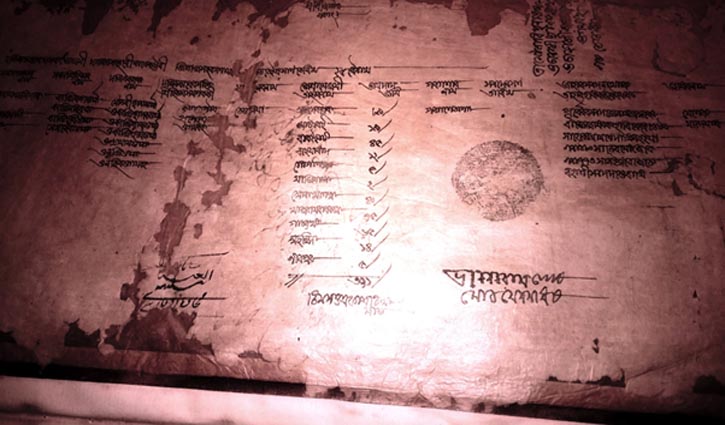
A seemingly over-200-year-old document listing Qazi Baqaullah along with other Qazis, in Bangla

The above is the Contents page of the family tree, which lists Tetulia as the very first mauza (land area for tax-collection purposes), followed by Gahuna (currently Ghuna), then Tala (name unchanged today), thereafter Ataroi (unchanged), then Diapara (unidentified, though Dewali Para and Deara exist), Mirzanogor (unchanged), Shaikhpura (unchanged), Jikhra (Jhikra as currently known), Meherpur (unchanged), Gobindopur (unchanged), Kanshipur (the same as today), Sorolia (Shorolia as called now), Shiner Gati (Shiner Ganthi, though an interpreter has identified this to be Sonargaon near Dhaka), Uludanga (the same as today), Godaipur (unchanged), then a mauza I cannot decipher, followed by Borhon (Boron Dali exists today) then Bansda (Banshda) followed by Tabai or Tabae (unknown). By the way, Jashore is named Jasar or Josor.
This area of Bangladesh is prolific with palm trees and the aforesaid Tala presumably derives its name from an identical Arabic word which means a young palm tree. However, according to another source, the expression “Tala” is a corruption of the term “Taalaab”, meaning a “pond”, though I am not entirely convinced. Moreover, a particular palm tree – abundantly cultivated in this region – bears a fruit called “Taal” (Asian Palmyra Palm; scientific name being Borassus flabellifer), which again, in all likelihood, points to the origin in the Arabic language.
I have guesstimated that the family tree dates back (as some events are dated) to the 15th century (the pre-Mughal era) – basing this on the assumption that the first offspring was born, on average, on the twenty-sixth year of the birth of the father and, then, working backwards. The reason behind this deduction is that the male offspring were groomed as prospective candidates for the roles of Qazi and Shaikh, and to attain such a scholarly level would have required several years of learning, before marriage, in order to be academically au fait with the history and the Administration and be fluent in Farsi, Arabic, Bengali, Urdu, Hindi etc. Indeed, copies of Mughal seals (one is displayed below) name Qazi Baqaullah Khan as “Shaikh Baqaullah walad Shaikh Ateequllah”. In other words, “Shaikh Baqaullah, child of Shaikh Ateequllah”
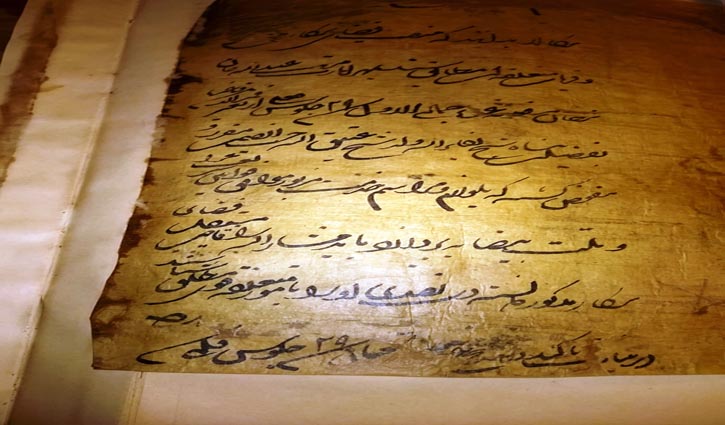
See the fourth line from the top of the unfaded lines of this original Mughal sanad, identifying Shaikh Baqaullah as the son of Shaikh Ateequllah.
The last serving feudal lord from the Tetulia Qazi Khan family was Khan Sahib Rizwanullah Khan; he and his younger brother, Qazi Muhammad Shafiullah Khan, were the residents of Salam Manzil, which, along with the area around it, they had jointly inherited as their ancestral home. Their descendants should now be the rightful owners. Their ancestors, going back to Qazi Shaikh Ateequllah (circa late-17th- and early-18th-century Bengal), were listed in my previous article published in January 2017 in this online newspaper. Qazi Ateequllah married the daughter of Qazi Abdul Ghani of Tala.
Going back further, Qazi Ateequllah was the son of Qazi Abdul Faraiz, who was one of the sons of Qazi Qutb, according to the family tree. Qazi Qutb’s father was Qazi Farid, who was the son of Qazi Abdus Salam. Qazi Abdus Salam was the son of Shah Hamza, whose father was Shah Sial (if I have not erred in reading the cursive writing). The latter was the son of Shah Behram, who is referred to as the “baashindah” (resident) of Hindustan (India of the early- or pre-Mughal period).
Qazi Farid’s younger brother, Qazi Taaj, married the daughter of Qazi Abdullah of Gahuna (Ghuna). So it is obvious that this family’s roots in Bengal go back several centuries. Prima facie it appears that the Tetulia Qazi family is one of the oldest Bengali Muslim families in this region – if not the oldest.
Qazi Baqaullah Khan was the youngest son of Qazi Ateequllah, whose other sons, starting from the eldest, were Maulvi Habibullah Khan, Qazi Najibullah Khan and Qazi Kalimullah Khan. Qazi Baqaullah Khan’s great-grandson was Khan Bahadur Salamatullah.
According to a copy of a Mughal sanad, which was issued in 1190 AH (1776 CE), Baqaullah Khan was entrusted to continue to govern as the Naib Qazi (Deputy Judge) of the district of Jashore (a photographic copy of the sanad was published in my previous article on this subject matter).
It appears from a perusal of a copy of another sanad that Qazi Shaikh Baqaullah Khan was empowered to have the honour of being the Qazi of the Sarkar (Government) of Fath-Abad, which, today, is known as the district of Faridpur. The sanad was, apparently, issued by Mir Jumlah Ubaid Khan Bahadur Turkhan, during the period of Badshah Ghaziullah Ahmed Shah Bahadur (1748–1754 CE). The year of appointment does not appear on the translated document, but apparently precedes that for Jashore.
According to a copy of another sanad, which was issued on 25th Dhul Hijjah 1203 AH (1789 CE), the title of Naib Qazi was bestowed upon Ifazatullah, after the demise of Qazi Saadatullah. Ifazatullah is identified from the family tree to be a son of Baqaullah Khan.
During about the same period, a copy of a sanad appears to entrust Kalimullah Khan, brother of Baqaullah Khan, to govern as the Qazi of the Sarkar of “Khalatabad”. I have been unable to locate “Khalatabad” in Bengal. It is unclear whether it is a misprint of Khalifatabad, which is the name given by the 15th-century warrior saint of Bengal – Khan Jahan Ali – to Bagerhat (Baagh-e-Raahat).
At around the same period, a sanad was issued to grant the post of Qazi to Muhammad Nusratullah, who, according to the family tree, was the son of Qazi Najibullah Khan (brother of Baqaullah Khan). This empowerment was for the governance of Shiner Ganthi.
Again, according to a Mughal sanad issued under Mir Jumlah Ubaid Khan Bahadur, during the reign of Ghaziullah Alamgir, the lawyer of Izzatullah – a son of Najibullah Khan – established that “since [his] client was holding the post of Qazi in the Sarkar of Gawalpara appertaining to the province of Orissa, it is confirmed that he should continue as such in accordance with the imperial order”. I am now, somewhat, doubtful that the province is, indeed, Orissa, as had been identified by the translator. My previous article, “Notable Heritage Sites – Requiring Preservation for Tourism”, published in this newspaper, should be read in the light of this.
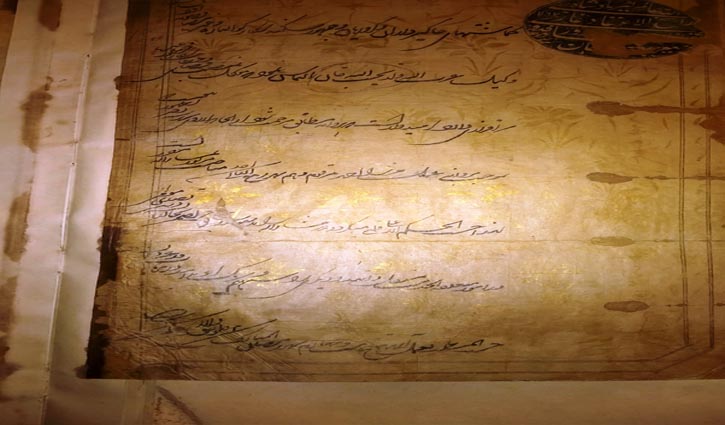
The above is a sanad granted to Izzatullah who was the son (walad) of Najibullah Khan, as encircled in pencil (second line from the top).
I have an English translation of another document, which was written to the Nawab of Bengal, informing him after an interview with him, that the post of Qazi of the Sarkar (it is unclear which one) was transferred to Muhammad Asadullah – a son of Habibullah Khan. The family tree reveals that Asadullah Khan came down to Tetulia from Delhi at the age of eighteen years.
So it follows that the brothers Najibullah Khan, Kalimullah Khan and the youngest, Baqaullah Khan, and their families and Asadullah Khan were entrusted with Mughal sanads to govern, as Qazis, a vast expanse of Bengal.
Notably, under “Maulvi Habibullah Khan” (the eldest of the brothers listed in the preceding paragraph) is recorded “Wazeer-e-A‘zam” (Prime Minister), from which can be established that the named person was the Prime Minister of the Mughal Administration. Another section of the family tree informs that Maulvi Habibullah Khan married the daughter of the Prime Minister Sa‘dullah Khan. So, within the realm of possibility, it can be surmised that Habibullah Khan assumed Sa‘dullah Khan’s role after the latter passed away.
A particular page of the family tree identifies Baqaullah Khan as being Chief Justice (Qazi-ul-Quzat), though the condition of the ink gives the impression that this insertion, in manuscript, had been made at a later date. So far, I have been unable to verify this declaration through independent sources other than from the book “Tala Upojelar Itihash–Oitijjo (History–Heritage of Tala Upazila)” by Badru Mohammad Khalequzzaman. Anyhow, Shaikh Baqaullah Khan appears in many of the Mughal sanads, suggesting that he was a very distinguished personality at the time. And it is very likely that he, eventually, played the role of Chief Justice.
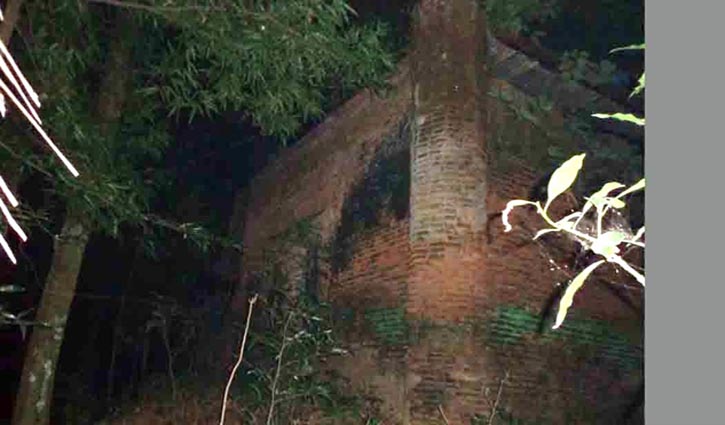
An exterior view of the Tentulia Shahi “Broken” Mosque associated with Qazi Najibullah Khan – courtesy of Rashedul Islam
I extend my thanks to Fakir Rashedul Islam for his photography on the Tetulia “Broken” Mosque.
The Tetulia Qazi family tree is so extensive that it provides evidence of family connections to as far afield as Lucknow (as apparent from a reference to Lucknow Mian) in Uttar Pradesh and Calicut in Kerala, both in present-day India.
A scrutiny of this family tree reveals very close family relationships between the Tetulia zamindar family and the zamindar families of Mirzanogor, Shaikhpura and Gobindopur of Bangladesh. Family ties, through marriage, with prominent Muslim families of Godaipur, Shorolia, Tala etc. of Bangladesh are also evident.
Many of the Muslim teachers and scholars who settled in this region as Mughal-appointed Qazis came from the Middle East and Central Asia upon the invitation of the Mughal emperors – in particular, Emperor Shah Jahan. Their knowledge on progressive Islam and an elevated command of Farsi, which was the court language of Mughal India, and Arabic were highly sought after by the Mughal kings. However, apparently, the Tetulia Qazi family predates the Mughal era.
One of the positive traits of these Qazis was to be able to assimilate very easily with the non-Muslim population – so much so that the non-Muslims were delegated with responsible posts in the Qazi Administration.
When the British Administration took over, after the fall of Nawab Siraj-ud-Daulah in 1757’s Battle of Plassey, they were quite impressed with the Qazi system and continued from where the Mughals had left off.
This article is written by Monty Siddique BSc (Hons) in Industrial Chemistry from a UK university, who took early retirement from the United Kingdom Civil Service, after having served as a Senior Patent Examiner (above Principal Level) in the United Kingdom Intellectual Property Office, which is the operating name of the United Kingdom Patent Office. He has also trained and managed UK patent examiners. The transliteration of the Arabic passages was facilitated by space scientist Nooreen Siddique, who also did some editing.
Dhaka/Mukul





